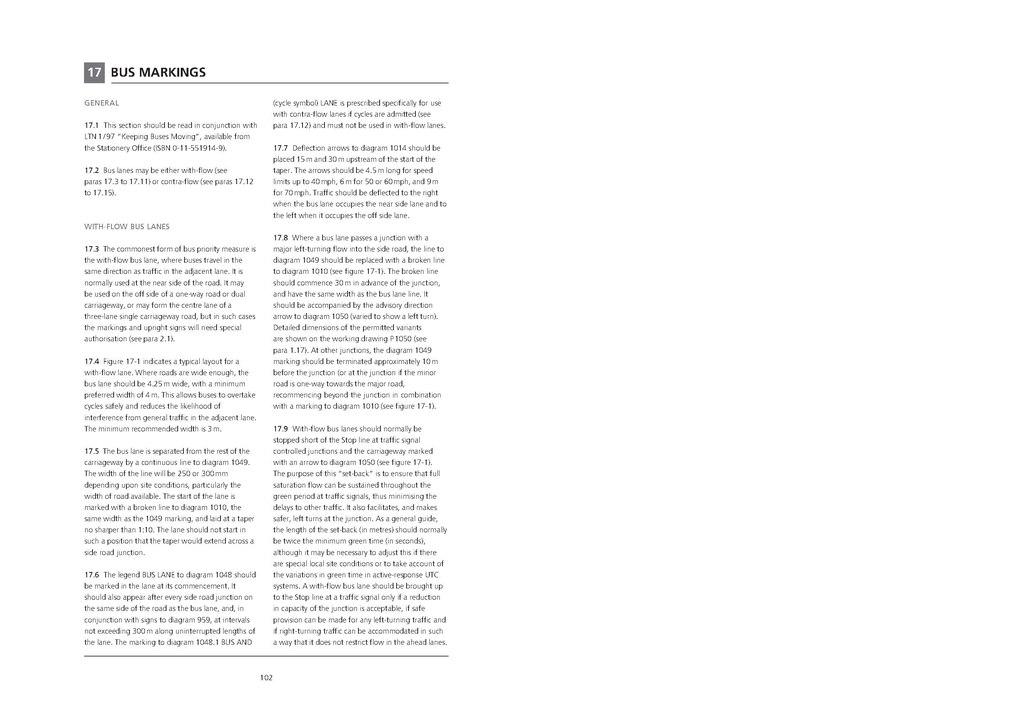17BUS MARKINGS
GENERAL
17.1 This section should be read in conjunction with LTN 1 / 97 "Keeping Buses Moving", available from the Stationery Office (ISBN 0-11-551914-9).
17.2 Bus lanes may be either with-flow (see paras 17.3 to 17.11) or contra-flow (see paras 17.12 to 17.15).
WITH-FLOW BUS LANES
17.3 The commonest form of bus priority measure is the with-flow bus lane, where buses travel in the same direction as traffic in the adjacent lane. It is normally used at the near side of the road. It may be used on the off side of a one-way road or dual carriageway, or may form the centre lane of a three-lane single carriageway road, but in such cases the markings and upright signs will need special authorisation (see para 2.1).
17.4 Figure 17-1 indicates a typical layout for a with-flow lane. Where roads are wide enough, the bus lane should be 4.25 m wide, with a minimum preferred width of 4 m. This allows buses to overtake cycles safely and reduces the likelihood of interference from general traffic in the adjacent lane. The minimum recommended width is 3 m.
17.5 The bus lane is separated from the rest of the carriageway by a continuous line to diagram 1049. The width of the line will be 250 or 300 mm depending upon site conditions, particularly the width of road available. The start of the lane is marked with a broken line to diagram 1010, the same width as the 1049 marking, and laid at a taper no sharper than 1:10. The lane should not start in such a position that the taper would extend across a side road junction.
17.6 The legend BUS LANE to diagram 1048 should be marked in the lane at its commencement. It should also appear after every side road junction on the same side of the road as the bus lane, and, in conjunction with signs to diagram 959, at intervals not exceeding 300 m along uninterrupted lengths of the lane. The marking to diagram 1048.1 BUS AND (cycle symbol) LANE is prescribed specifically for use with contra-flow lanes if cycles are admitted (see para 17.12) and must not be used in with-flow lanes.
17.7 Deflection arrows to diagram 1014 should be placed 15 m and 30 m upstream of the start of the taper. The arrows should be 4.5 m long for speed limits up to 40 mph, 6 m for 50 or 60 mph, and 9 m for 70 mph. Traffic should be deflected to the right when the bus lane occupies the near side lane and to the left when it occupies the off side lane.
17.8 Where a bus lane passes a junction with a major left-turning flow into the side road, the line to diagram 1049 should be replaced with a broken line to diagram 1010 (see figure 17-1). The broken line should commence 30 m in advance of the junction, and have the same width as the bus lane line. It should be accompanied by the advisory direction arrow to diagram 1050 (varied to show a left turn). Detailed dimensions of the permitted variants are shown on the working drawing P 1050 (see para 1.17). At other junctions, the diagram 1049 marking should be terminated approximately 10 m before the junction (or at the junction if the minor road is one-way towards the major road, recommencing beyond the junction in combination with a marking to diagram 1010 (see figure 17-1).
17.9 With-flow bus lanes should normally be stopped short of the Stop line at traffic signal controlled junctions and the carriageway marked with an arrow to diagram 1050 (see figure 17-1). The purpose of this “set-back” is to ensure that full saturation flow can be sustained throughout the green period at traffic signals, thus minimising the delays to other traffic. It also facilitates, and makes safer, left turns at the junction. As a general guide, the length of the set-back (in metres) should normally be twice the minimum green time (in seconds), although it may be necessary to adjust this if there are special local site conditions or to take account of the variations in green time in active-response UTC systems. A with-flow bus lane should be brought up to the Stop line at a traffic signal only if a reduction in capacity of the junction is acceptable, if safe provision can be made for any left-turning traffic and if right-turning traffic can be accommodated in such a way that it does not restrict flow in the ahead lanes.
102
